Karnataka’s Coorg, aka Kodagu, district offers not only rain-forests but a diverse array of natural wonders, including grassy glades, paddy fields, roaring waterfalls, deep gorges and gushing rivers – Punita Malhotra
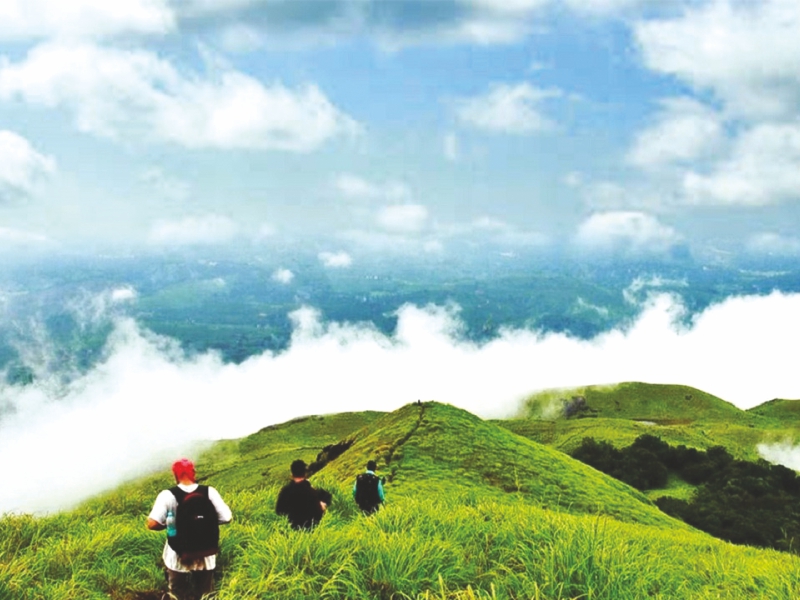
The mention of Coorg (aka Kodagu) conjures up visions of thick, green rainforests shrouded in ethereal floating mist. But to truly appreciate the rich tapestry of its topography, visitors must venture deep into this hill district sited on the eastern edge of the Western Ghats in the southern state of Karnataka (pop.63 million). Spread over 4,000 sq. km, Coorg (pop.5.5 lakh) is often described as Scotland of India. It offers not only rainforests but a diverse array of natural wonders, including grassy glades, green paddy fields, roaring waterfalls, deep gorges and gushing rivers. Located at an altitude of 3,000-5,500 ft above sea level amidst cloud-soaked mountains, Coorg receives an average of 2,500 mm of rainfall every year.
These cool weather conditions and hilly topography are perfect for coffee plantations. Coorg is the largest coffee-producing district of India and also hosts expansive tea gardens and orange groves. Moreover, as the adventure capital of Karnataka, it offers diverse adrenaline-pumping outdoor sports including quad biking and kayaking. Moreover, history buffs can dive deep into the rich cultural traditions and architectural heritage of the local Kodava community.
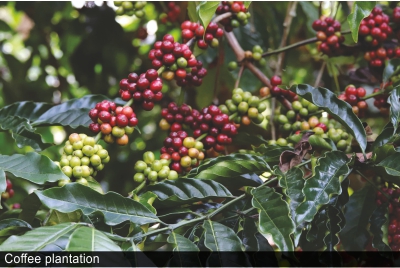 Madikeri
Madikeri
Madikeri, the administrative capital of Coorg district, is the ideal starting point to explore the district. Sight-seeing options abound in this small town (pop.33,381). The marketplace welcomes visitors with a charming row of shops that advertise endless varieties of homegrown produce such as coffee, local chocolate, spices and wine. Tibetan monks in dark red garments and traditional Kodava houses provide a fascinating first glimpse into the region’s culture.
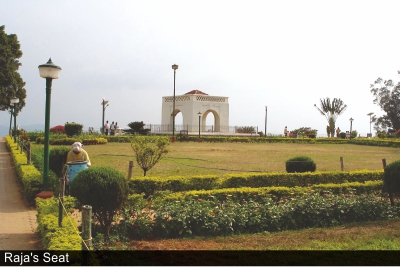 For heritage lovers, a guided walking tour of the town is a must on the wish-list. The most popular attraction is Raja’s Seat. Once a favourite hangout of the Kodagu royalty, this public garden attracts sizeable crowds keen on enjoying its 360-degree panoramic vistas and breathtaking sunsets and sunrises.
For heritage lovers, a guided walking tour of the town is a must on the wish-list. The most popular attraction is Raja’s Seat. Once a favourite hangout of the Kodagu royalty, this public garden attracts sizeable crowds keen on enjoying its 360-degree panoramic vistas and breathtaking sunsets and sunrises.
Also check out the imposing Madikeri Fort & Palace. Originally built of mud during the 17th-century, it was rebuilt with granite during the reign of Tipu Sultan (1750-1799), ruler of the Mysore kingdom. The palace is a two-storied building constructed in European style with grand pillars and checkered floors. Other noteworthy pitstops in the complex are a Gothic-style church with stained glass windows, now a museum, the Kote Maha Ganapathi Temple, Mahatma Gandhi Public Library and District Prison. Young visitors will be delighted at the prospect of discovering the maze of secret passageways within the palace complex.
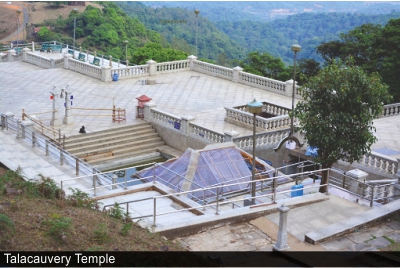 Not far away, is the Omkareshwara Temple. Built by Linga Rajendra II in 1820, this revered Shiva temple is an interesting blend of Hindu and Islamic architectural styles, featuring a dome-shaped structure in the middle of a pond with four Moorish turrets on all sides and tiled roofs. A short drive away is Talacauvery, the starting point of the much-revered River Cauvery. Talacauvery has a special significance for locals, as the word Kodava translates to ‘blessed by Mother Kaveri’.
Not far away, is the Omkareshwara Temple. Built by Linga Rajendra II in 1820, this revered Shiva temple is an interesting blend of Hindu and Islamic architectural styles, featuring a dome-shaped structure in the middle of a pond with four Moorish turrets on all sides and tiled roofs. A short drive away is Talacauvery, the starting point of the much-revered River Cauvery. Talacauvery has a special significance for locals, as the word Kodava translates to ‘blessed by Mother Kaveri’.
Another iconic site synonymous with Coorg is Bylakuppe. This largest Tibetan settlement in India is known for its several gilded-statue laden monasteries. Notable among them are Sera Mey, Great Gompa of Sera Je, Namdroling and Tashi Lhumpo, seat of the Panchen Lama.
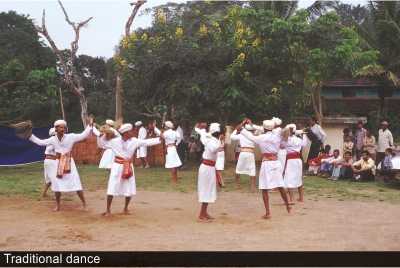 Cultural immersion
Cultural immersion
A sojourn in Coorg is incomplete without experiencing the indigenous culture of local Kodavas. Fascinating tales surround the origin of this tribe, including stories of lineage from Alexander the Great and a band of Iraqi Kurds. Primarily a community of hunters and harvesters, Kodavas are known for their expertise in martial arts. Over the centuries, this region’s recorded history has been coloured with the influence of several powerful South Indian kingdoms including the Pandyas, Cholas, Hoysalas, Vijayanagar Empire, Nayaks, Changavas, Lingayat Rajas and Wodeyars.
Legends recount bloody battles against Haider Ali, Tipu Sultan and the British, where this martial tribe defended its territory using expert guerrilla tactics and centuries-old war-trenches known as kadangas. These trenches, varying from 1.5-7.5 metres in height, and 2-3 metres in width, are spread across the countryside. With the help of a local guide, visitors can discover them deep in mountainside foliage. The invaders are long gone, but martial traditions continue to reflect in Kodava lifestyle. To this day every Kodava is legally entitled to possess a firearm without an arms licence. Some of the more famous sons of the district include Field Marshal Cariappa and General K.S. Thimayya, both Indian Army chiefs of staff.
Masked by modernity, deeply rooted in genealogy, the Kodavas are an intriguing people, still retaining the essence of their distinctive culture. A host of ancient traditions are kept alive and practised with full sincerity and community spirit. Every Kodava is a member of one of 300 clans and has a strong belief in ancestor worship. In the ancestral house (ainmane) of every clan, there’s a small shrine for prayers to ancestors. In marriages, family elders (rather than priests) guide ceremony proceedings. Brides and grooms sport traditional costumes and typical jewellery. Women wear the Kodavu style saree, with pleats on the back and a knot on the shoulder. Men wear a coat-sash garment and wear a ceremonial dagger and sword.
During annual harvest festivals, the Kodavas perform tribal song-and-dance sequences and symbolically worship weapons such as swords, canes and whisks. Attending one of these events can be an entertaining and enlightening experience for all age groups.
Connect with nature
 The preferred option to connect with nature in Coorg is to sign up for a guided rainforest walk. Children will especially enjoy this expedition and learn about biology, ecology and environmental science while soaking in lush landscapes and wilderness. Rare flora-fauna thrive in Kodagu rainforests, including the magical and tropical medicinal tree, garcinia cambogia, which produces a concentrated juice, recognised worldwide as a liver protector and weight reducer; strangler figs; rudraksh and sandalwood trees; healing plants and herbs, fruits, spices such as cardamom, pepper and vanilla pods. The district’s lush rainforests also host over 40 species of frogs, including the endangered Ponmudi bush frog, butterflies, bees, termites, snakes, among other species.
The preferred option to connect with nature in Coorg is to sign up for a guided rainforest walk. Children will especially enjoy this expedition and learn about biology, ecology and environmental science while soaking in lush landscapes and wilderness. Rare flora-fauna thrive in Kodagu rainforests, including the magical and tropical medicinal tree, garcinia cambogia, which produces a concentrated juice, recognised worldwide as a liver protector and weight reducer; strangler figs; rudraksh and sandalwood trees; healing plants and herbs, fruits, spices such as cardamom, pepper and vanilla pods. The district’s lush rainforests also host over 40 species of frogs, including the endangered Ponmudi bush frog, butterflies, bees, termites, snakes, among other species.
The rainforests also host sacred groves, known as devarakadu, left untouched for centuries to respect mythical deities. Of the estimated 4,125 sacred groves sited in India, nearly 1,214 spread across 2,500 hectares are under 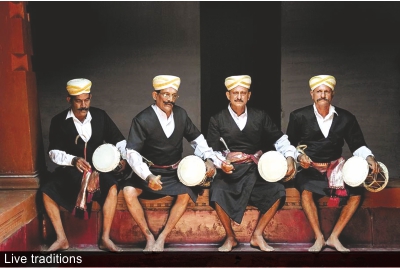 protection in Kodagu. Since ancient times, Kodavas have been animists, freely roaming wild forests, venerating, celebrating and worshipping nature’s bounty. Sacred groves and springs, oracles and mysteries continue to be respected by their belief systems. Although currently a progressive liberal community that has smoothly adapted to urban lifestyles, the community proudly upholds its unique identity. The dangers of invasion are over and so is their suspicion of visitors and tourists to their sacred forests. Inhaling the purest of air in thick of the lichen-covered and moss-draped rainforest in Coorg, one understands why Kodavas are in the vanguard of movements to save the planet from environmental degradation.
protection in Kodagu. Since ancient times, Kodavas have been animists, freely roaming wild forests, venerating, celebrating and worshipping nature’s bounty. Sacred groves and springs, oracles and mysteries continue to be respected by their belief systems. Although currently a progressive liberal community that has smoothly adapted to urban lifestyles, the community proudly upholds its unique identity. The dangers of invasion are over and so is their suspicion of visitors and tourists to their sacred forests. Inhaling the purest of air in thick of the lichen-covered and moss-draped rainforest in Coorg, one understands why Kodavas are in the vanguard of movements to save the planet from environmental degradation.
In a district that produces 60 percent of the country’s coffee, a coffee plantation tour is mandatory. Most tours last for two hours and are provided by local plantation owners themselves. The typical tour involves a trek through the coffee bushes, carefully trimmed to heights suitable for bean-picking. Children will learn to recognise tall silver oaks and short orange trees and understand their role in providing shade to coffee bushes. These tours also acquaint visitors with Robusta and Arabica coffee and blending processes, the role of chicory in coffee production and marketing. Harvesting-plucking, production, drying, etc are explained first-hand. The instant-versus-filter coffee quality debate is sorted, and usually the tour ends with a tasting session of freshly brewed coffee.
adventure excursions
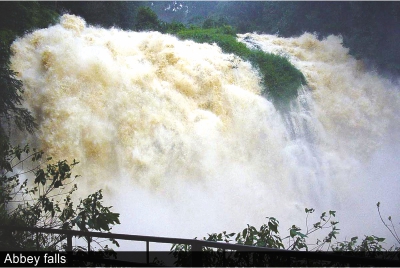 For water-starved urbanites the roaring waterfalls of Coorg are a sight to behold. The most famous are the cascades of Abbey and Irupu falls. While the former is sited 15 minutes north of Madikeri, reaching the latter mandates a two-hour drive in the opposite direction. Continuing in the same direction for another hour, visitors can try their luck at wildlife spotting at Nagarhole National Park, one of the best maintained national parks of India. A special feature is watching elephants being bathed in the River Kabini at the Dubare Elephant Camp.
For water-starved urbanites the roaring waterfalls of Coorg are a sight to behold. The most famous are the cascades of Abbey and Irupu falls. While the former is sited 15 minutes north of Madikeri, reaching the latter mandates a two-hour drive in the opposite direction. Continuing in the same direction for another hour, visitors can try their luck at wildlife spotting at Nagarhole National Park, one of the best maintained national parks of India. A special feature is watching elephants being bathed in the River Kabini at the Dubare Elephant Camp.
More adventurous tourists could head to the base camp of Kutta to embark on the challenging Brahmagiri Trek. The other sought-after base, Kakkabe, is famous for its 5-km Tadiandamol Trek to the highest peak in Coorg. For riverine adventures, there is the option of river rafting over the gushing frothy rapids of the Upper Barapole River; kayaking 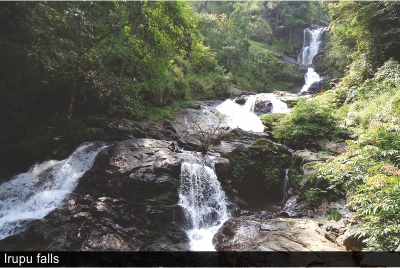 or canoeing on the River Kakkabe; or quad biking through forests and slush on a 1-km circuit. Visitors can also look forward to zip-lining over the forest and negotiating obstacle courses involving walkways, bridges and tunnels.
or canoeing on the River Kakkabe; or quad biking through forests and slush on a 1-km circuit. Visitors can also look forward to zip-lining over the forest and negotiating obstacle courses involving walkways, bridges and tunnels.
Unique cuisine
Coorg boasts a unique culinary tradition. The cuisine is predominantly non-vegetarian, and pork is a favoured delicacy. Kachampuli (dark vinegar) is used as the gravy sauce base for most dishes, especially non-vegetarian, and green chillies are preferred to red. Rice and rice-based breads are staples. Locally grown ingredients such as jungle mangoes, jackfruit, edible colocasia and rice are generously used in all culinary preparations.
Some popular Kodava specialties include pandi (pork) curry, chilli fish steamed in cardamom leaves, mango curry, 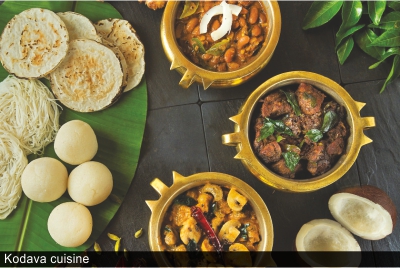 kadambuttu (steamed rice balls) akki (rice) roti, noo-puttu (string hoppers), otti (baked pieces of rice flour) and pulao rice. Koovaleputtu, a savoury dish made from ripe jackfruit or banana, steamed in banana leaves is another popular preparation. For those with a sweet tooth, the dessert of choice is kajaya, deep-fried doughnuts made from jaggery and rice flour.
kadambuttu (steamed rice balls) akki (rice) roti, noo-puttu (string hoppers), otti (baked pieces of rice flour) and pulao rice. Koovaleputtu, a savoury dish made from ripe jackfruit or banana, steamed in banana leaves is another popular preparation. For those with a sweet tooth, the dessert of choice is kajaya, deep-fried doughnuts made from jaggery and rice flour.
Best time to visit
October to May is the best time to visit with the peak season being February-May. Coorg is also a great monsoon getaway with its swollen waterfalls and rivers and lush forests providing awe-inspiring vistas.
Getting there
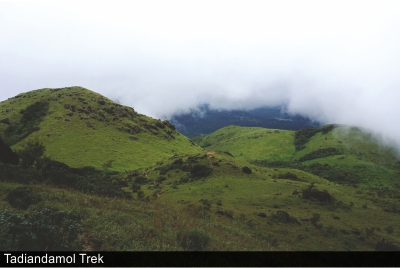 The closest airport and railway hubs are Mysore (130 km) and Bangalore (280 km). Frequent buses ply from Bangalore, Mysore and Mangalore. Also good road connectivity makes self-driving a breeze.
The closest airport and railway hubs are Mysore (130 km) and Bangalore (280 km). Frequent buses ply from Bangalore, Mysore and Mangalore. Also good road connectivity makes self-driving a breeze.
Accommodation
A wide range of options is available from budget homestays to cozy plantations and luxurious resorts. Top-end: Taj Madikeri (Rs.18,200 onwards per night), Evolve Back (Rs.24,000), Club Mahindra Madikeri (Rs.8,343). Mid-range: Honeypot Homes (Rs.4,500), Silver Brook Estate (Rs.3,500). Budget: Treebo Trend Vrindavan (Rs.2,200), Inn Coorg Homestays (Rs.2,800).
Also read: Traveling with kids? Useful tips for parents
























